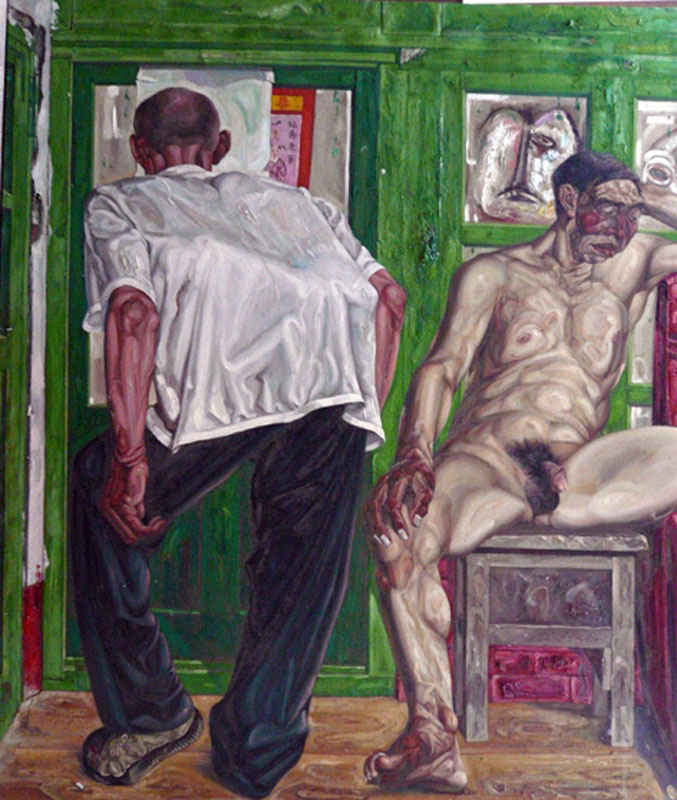Contemporary Chinese Art- another kind of view
DSL Collection
Lao Guan in back and nude
More information on the works
More information on the works
Liu Rentao On People
"There are elements of New Year* pictures that play a significant role in my works. The effects of red tones, the brightness of colour and a glossy sheen to the paint each inspired me in their own way. The implications latent in Spring Festival paintings also appealed to me. I took what I saw as the best elements and dissolved them into my painting. The reason they are so significant throughout the country is that they contain many facts of Chinese existence wrapped up in a visual spectacular. They are a form of folk art which have been popular in China for a long time, especially amongst the common people. They are perhaps China's true popular art for they can be found everywhere. I imported the main elements of these New Year pictures to my oil paintings, but I retained the creative approach upon which they depend, paring the technique from the themes conventional to the New Year stories and aspirations. I am more interested in creating my own style, my own spirit, and illustrating a political or social comment.
Let's just say I am taking New Year's pictures one step further, creating a new way to reflect society, for after all, shouldn't this be implicit in the activity of creation?
* New Year pictures were a tradition of folk art that began in the Song Dynasty whence it became a habit to paste colourful images of fortuitous spirits either side of the main entrance to a house. This act was believed to ensure good fortune and prosperity for the inhabitants. This tradition continued right through to the twentieth century until, following the Liberation of China from the previous feudalist era of beguiling superstition, the Communists sought to remove hocus-pocus and mumbo-jumbo from Chinese minds. This was nigh-on an impossible task for it is in human nature to believe in an "other". Realising this, the Communists led a new movement that one might title the "Neo-New Year Movement", where they reintroduced the possibility of this decorative folk art but took control of the subject matter, issuing instructions concerning images and elements, colour, mood and theme. No shadows, no classical reference - unless it was to denounce the old - and lots about the good new gospel of Maoism. The movement was massive and warmly received. To date it is still possible to find examples of revolutionary New Year paintings. In the present day, the tradition has dwindled to a factory activity, denied all the quality, inspiration and love that went into those produced in true faith, be it pagan or socialist."
Liu Rentao
"There are elements of New Year* pictures that play a significant role in my works. The effects of red tones, the brightness of colour and a glossy sheen to the paint each inspired me in their own way. The implications latent in Spring Festival paintings also appealed to me. I took what I saw as the best elements and dissolved them into my painting. The reason they are so significant throughout the country is that they contain many facts of Chinese existence wrapped up in a visual spectacular. They are a form of folk art which have been popular in China for a long time, especially amongst the common people. They are perhaps China's true popular art for they can be found everywhere. I imported the main elements of these New Year pictures to my oil paintings, but I retained the creative approach upon which they depend, paring the technique from the themes conventional to the New Year stories and aspirations. I am more interested in creating my own style, my own spirit, and illustrating a political or social comment.
Let's just say I am taking New Year's pictures one step further, creating a new way to reflect society, for after all, shouldn't this be implicit in the activity of creation?
* New Year pictures were a tradition of folk art that began in the Song Dynasty whence it became a habit to paste colourful images of fortuitous spirits either side of the main entrance to a house. This act was believed to ensure good fortune and prosperity for the inhabitants. This tradition continued right through to the twentieth century until, following the Liberation of China from the previous feudalist era of beguiling superstition, the Communists sought to remove hocus-pocus and mumbo-jumbo from Chinese minds. This was nigh-on an impossible task for it is in human nature to believe in an "other". Realising this, the Communists led a new movement that one might title the "Neo-New Year Movement", where they reintroduced the possibility of this decorative folk art but took control of the subject matter, issuing instructions concerning images and elements, colour, mood and theme. No shadows, no classical reference - unless it was to denounce the old - and lots about the good new gospel of Maoism. The movement was massive and warmly received. To date it is still possible to find examples of revolutionary New Year paintings. In the present day, the tradition has dwindled to a factory activity, denied all the quality, inspiration and love that went into those produced in true faith, be it pagan or socialist."
Liu Rentao

